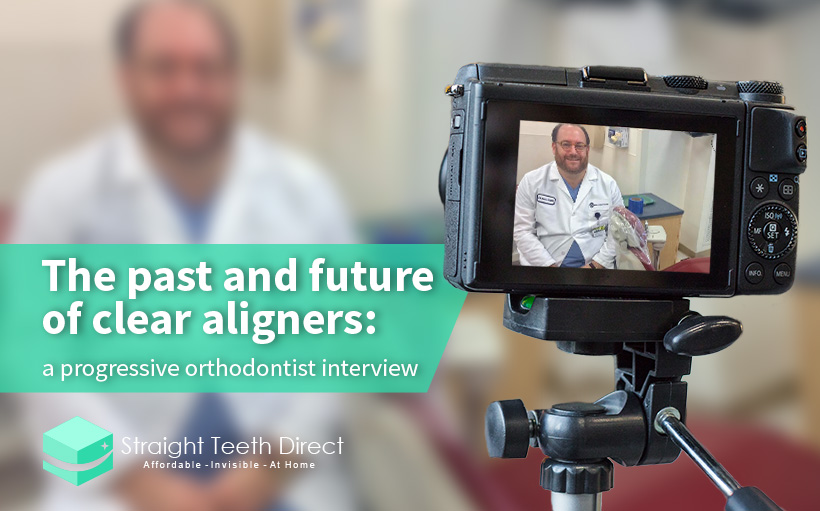
The past and future of clear aligners: a progressive orthodontist interview

Guest post from specialist orthodontist, Dr Marc Ackerman, DMD, MBA
Hi Dr Marc Ackerman, what made you want to become an orthodontist and what is your area of interest today?
My Father and Grandfather were orthodontists, so I am not entirely sure whether or not it was nature or nurture! In all seriousness, when I was in dental school I attended a lecture that my Dad gave on esthetics and surgical orthodontics. The facial change that occurred due to the jaw surgery was unbelievable. I have spent the first 20 years of my orthodontic career studying the esthetics of the smile and have provided appearance driven orthodontic enhancement to a wide array of consumers. My current interest in orthodontics is increasing access to care for consumers with physical and mental handicaps. These consumers are often overlooked and deserve to receive all of the appearance enhancements that their peers are being offered.
Have you noticed a shift in the way things are done since you graduated?
Yes, over the course of the last 20 years, orthodontics has embraced new technologies and focused on the esthetics of the smile. When I graduated, it was complete heresy to say that you were just improving a consumer’s smile. Orthodontics was strictly fixing bites and orthodontists demanded that consumers undergo a complete overhaul of how their teeth meet.
When did you start using clear aligners to treat your patients?
I started using clear aligners in approximately 2003.
Were there any frictions when aligners came out on the market and did it take a while become accepted as a valid solution?
Orthodontists completely dismissed clear aligners when they entered the marketplace. Although many of the leading orthodontists are using aligners, there is still tremendous resistance to them. The crux of the issue goes back to “fixing bites” versus “fixing smiles”. There is absolutely no evidence that the vast majority of patients need bite fixing.
Can you explain the difference between conventional orthodontics and enhancement orthodontics?
I wrote a book in 2007 that was titled, Enhancement Orthodontics: Theory and Practice. The premise was that consumers elect to have orthodontics to improve the appearance of their smile. If a consumer just wants their front teeth straightened, there shouldn’t be any professional barrier to that. Conventional orthodontics does not take into consideration the wants of the consumer and looks at straightening anything less than the whole mouth as substandard care. This is clearly not the case.
Why do some orthodontists call malocclusion a disease? Do you think it is one?
In order to be a patient you have to suffer from a disease. The father of modern orthodontics, Edward H. Angle, medicalised orthodontics by creating malocclusion, the disease. Crooked teeth is not a disease but a social condition. I came to the conclusion long ago that we enhance the appearance of consumers and not patients
What are the main differences between fixed braces and clear aligners?
Fixed braces are glued to the teeth and are connected together by a wire. As larger sizes of wires are placed in the braces, the teeth move accordingly. Fixed braces require many periodic visits to the orthodontist to have the wire changed and at these visits some of the braces may be repositioned when the teeth aren’t moving correctly. By and large, fixed braces require a greater commitment of time, money, and are not as comfortable as the clear aligner alternative. Clear aligner treatment utilizes a series of custom made plastic trays that gradually move your teeth over time. These trays are worn all the time save eating. The orthodontist doesn’t need to see the clear aligner consumer nearly as often as the traditional fixed braces consumer.
When do you tend to recommend clear aligners and when would you not?
I would recommend clear aligner treatment to any consumer that wants them. What the consumer needs to know is that the aligners can’t fix everything when it comes to overbites, underbites, open bites, etc. but they can significantly improve many tooth alignment issues.
The top benefits and disadvantages of clear aligners
The top benefits of clear aligners are comfort, custom fabrication, and ease of use. The disadvantage of clear aligners is that consumers have to be committed to wearing them in order for the smile to improve.
What cases are ideal to treat remotely with clear aligners?
I would say that any clear aligner case that I would accept for treatment would be a candidate for remote monitoring.
What differences are there between in-office and tele-supervised clear aligners?
Doctor-directed in office aligners can be fabricated utilizing an intra-oral scanner to capture the 3D images of the teeth in each arch. Doctor-directed at home aligners are more dependent on consumers taking their own impressions with a putty. Both methods work equally well. As far as the teeth moving and course correction, I see no major differences.
Why do you think some orthodontists are apprehensive of Teledentistry?
I think that it is the same reason that physicians are apprehensive of telemedicine. The average orthodontist feels that they are losing control in some way. As well, they fear that some type of grave error will be made without face-to-face contact. It really is unfounded.
Is clear aligner a more popular solution amongst adults or teenagers?
I would say that more adults are receiving aligner treatment than teens, however many teens are keen on being treated with aligners but haven’t been given the choice.
Are there any major differences between clear aligner brands out there?
I see the major difference being the user experience and journey.
What are the different types of retainers available and how do they work?
There are two main types: fixed and removable retainers. Fixed retainers are wires glued behind the teeth in order to keep them straight. These types of retainers work well but are very technique sensitive and require much more work to clean and maintain good oral hygiene. If they break, the consumer may not know it until the teeth have shifted. In terms of removable retainers, there are 2 types: the traditional wire and acrylic retainer and the clear aligner. These types of retainers come in and out of the mouth. My recommendation is that they be worn at night only. Just like aligner treatment, the consumer has to comply wearing them.
What % of people in the future do you think will seek straighter teeth?
I think that there will be a significant jump in consumers seeking orthodontic treatment as the price becomes more affordable and treatment via the digital platform becomes easier for them.
How do you see the future of orthodontics delivered?
I see two types of orthodontic delivery systems. For the vast majority of consumers, who would like a recognisable change in their appearance/smile, orthodontics will be delivered digitally with the doctor directing at home treatment. For a much smaller subset of consumers with advanced problems outside the range of normal variation, orthodontics will be delivered in-office albeit with greater use of technology.
If you are looking for a convenient and affordable way to enhance your smile, make sure you submit your teeth photos here to find out if doctor-directed at home aligners could work for you.

Not quite sure yet?
Fill in your email and we'll send you more details!















